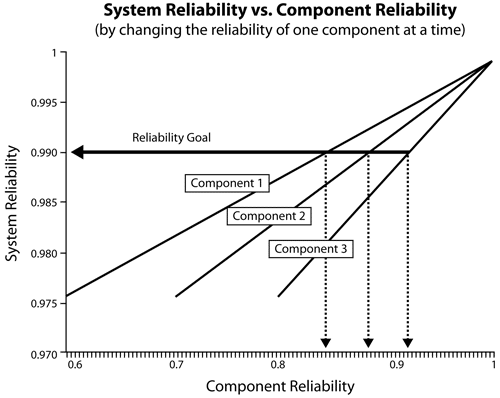Join the Professional Communication Society Chapter of IEEE Philadelphia for an Engineering Book Review/Discussion - May 28th 7:00pm ET. Earn PDU/recertification units.
Choose Reliability Goals for Modules
We have a reliability target for our system. But we're not meeting it.
To avoid this scenario, what is something we can do in early development?
When we're figuring out our concept, we can better learn about our options. We can work with Reliability Engineers to understand what we know, the risk in what we don't know, and to prioritize reliability of the modules to be able to meet the reliability of our whole system.
We talk about using reliability allocation to help us choose reliability goals for modules of our product design. And we talk about its limitations.
We looked at a product design from a systems point-of-view, where the system is made of modules.
Things Design Engineers can do to help with Reliability Allocation methods:
- Share the general architecture of the system.
- Find good reliability data.
- Find parts to test. This is a great option, but sometimes not realistic at the time we want to make design choices.
- Find data on related/similar systems or modules. Ask vendors and research baseline design information.
- Prioritize for test
- Evaluate the Systems Architecture Diagram - what is new, different, or has been a problem in the past? Highlight them because those are things we want to be curious about.
- Use our System FMEA (and/or hazards analysis) as a starting point.
- Is a module leading to many failure events? (Occurrence rating, or number of times it comes up)
- Does a module failure lead to a whole system failure? (our Severity rating)
Depending on the data and information available, Reliability Engineers may be able to use software tools to look more closely at reliability targets among the system's modules:
- create scenarios of varying reliability targets for modules (reliability block diagrams that use reliability functions)
- compare the modules based on the probability of a module to cause a system failure (using a ratio of reliability functions)
- meet a system reliability while minimizing cost (aligning module reliability targets and considering costs of improving the reliability of modules)
- compare options using the cost of increasing the reliability of modules (using a weighted, subjective factor)

From System Analysis Reference Book by ReliaSoft Corporation. Retrieved December 2, 2022, from ReliaWiki.org. Available under a a Creative Commons Attribution-NonCommercial-ShareAlike 4.0 International License.
There are limitations with reliability predictions.
Calculating reliabilities without test is tempting (relying on physics of failure or mean failure times), but we sacrifice accuracy and can't report on a reliability with confidence.
Like other things in product development, we start with knowing very little, analyze the information we have to make decisions, and then iterate on those analyses as we learn more about the product. Reliability allocation is like that, too.
Even with information and if we find relevant data, uncertainty is just part of reliability predictions. That doesn't mean that it's not worth doing. The team just needs to understand the uncertainty and make decisions with it appropriately.
What's today's insight to action?
We can work with Reliability Engineers in early concept phases with reliability allocation to help us:
- assess where we should be designing for reliability improvements
- see where we have knowledge gaps and where risks may lie
- understand how changing probabilities of failure of subsystems or modules can affect our overall system reliability goals
- plan for reliability tests later in development
Ultimately, Reliability Engineers can help us better understand where we need to focus for great designs.
To learn more about how to do reliability allocation, I recommend this article series authored by Chris Jackson:
3 Ways to do Reliability Allocation #1 - Accendo Reliability
3 Ways to do Reliability Allocation #2 - Accendo Reliability
3 Ways to do Reliability Allocation #3 - Accendo Reliability
3 Ways to do Reliability Allocation #4 - Accendo Reliability
3 Ways to do Reliability Allocation #5 - Accendo Reliability
Other Quality during Design podcast episodes you might like:
How Does Reliability Engineering Affect (Not Just Assess) Design?
Other podcasts about allocation:
SOR 884 Allocating Reliability - Conundrum - Accendo Reliability


